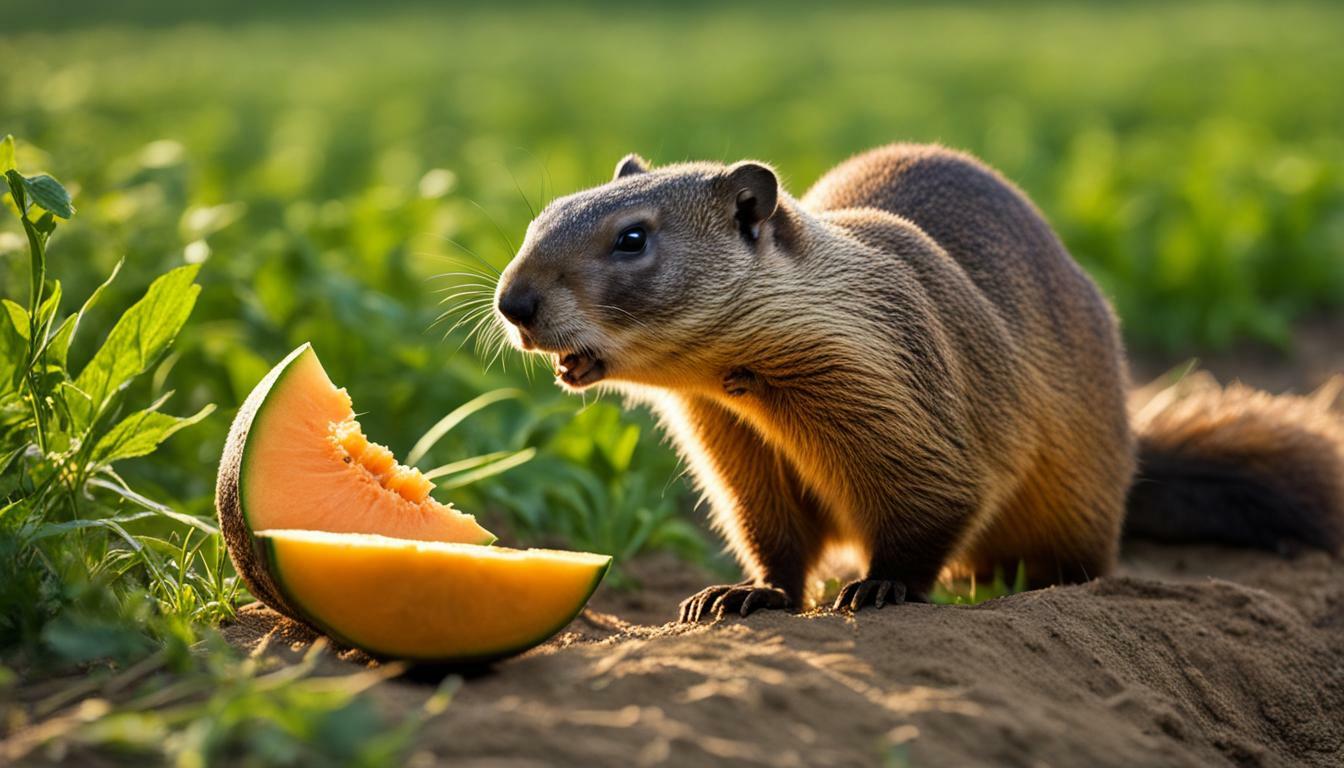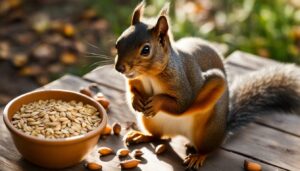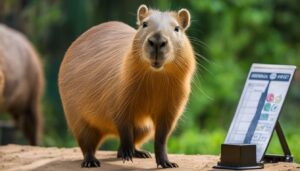Groundhogs, also known as woodchucks, are herbivores with a varied diet that includes fruits and vegetables. But do they actually eat cantaloupe?
Factual data: Groundhogs, also known as woodchucks, are herbivores and do eat cantaloupe. However, the amount and frequency of cantaloupe consumed by a groundhog will depend on factors such as the ripeness of the fruit and the groundhog’s feeding habits. Groundhogs are attracted to sweet fruits like ripe cantaloupe due to their sugar content. They are also known to raid gardens for their favorite foods, causing damage to crops. If you have a garden with cantaloupe, it’s important to take preventive measures such as fencing or using repellents to protect your crops from groundhogs. It’s also worth noting that other animals like squirrels, raccoons, and deer may also be attracted to cantaloupe.
Key Takeaways:
- Groundhogs, or woodchucks, are herbivores and can eat cantaloupe.
- The amount of cantaloupe consumed by a groundhog depends on factors like fruit ripeness and feeding habits.
- Groundhogs are attracted to sweet fruits like ripe cantaloupe.
- They may raid gardens for their favorite foods, including cantaloupe, causing damage to crops.
- Protective measures like fencing and repellents can help prevent groundhog damage in your garden.
- Other animals like squirrels, raccoons, and deer may also be attracted to cantaloupe.
Understanding Groundhog Diet
Groundhogs have a primarily vegetarian diet, consisting mainly of grasses, leaves, flowers, and other plant material. These small mammals, also known as woodchucks, are herbivores that are well-adapted to foraging on a variety of plants in their natural habitat.
When it comes to groundhog food preferences, they tend to favor green vegetation, especially during the warmer months when plants are abundant. They have a particular liking for tender shoots and succulent leaves, making grasses and clovers a staple in their diet. Groundhogs also consume a wide range of other plants, including dandelions, plantain, and wildflowers.
Although groundhogs primarily feed on plant-based foods, they may occasionally incorporate some insects or snails into their diet. However, these animal-based foods make up a very small portion of their overall food intake. Groundhogs are not known to actively seek out animals for consumption but rather rely on their herbivorous nature for sustenance.
As part of their natural feeding habits, groundhogs also exhibit a behavior called “browsing,” where they move from plant to plant, sampling different types of vegetation. This browsing behavior allows them to meet their nutritional needs by consuming a varied diet and ensuring they obtain the necessary nutrients.
Groundhog Diet Summary
| Food | Preference |
|---|---|
| Grasses | High preference |
| Leaves | High preference |
| Flowers | Moderate preference |
| Other plant material | Varying preference |
| Insects and snails | Ocasional consumption |
Exploring Groundhog Food Preferences
While groundhogs primarily consume greens, they are known to enjoy indulging in fruits as well. Groundhog food preferences can vary depending on availability and personal taste. When it comes to fruits, groundhogs have been observed showing a particular fondness for melons, including cantaloupe.
In addition to cantaloupe, groundhogs may also eat other fruits such as berries and apples. These sweet treats provide a welcome change in their predominantly herbivorous diet. However, it’s important to note that the consumption of fruits by groundhogs is typically limited, and they mainly rely on greens like grasses, dandelions, and clover for sustenance.
Groundhogs are selective eaters and are more likely to indulge in fruits when they are at their ripest and sweetest. The sugar content in ripe fruits, including cantaloupe, plays a significant role in attracting groundhogs to these delectable treats. The enticing aroma and flavor of ripe cantaloupe make it a tempting choice for these curious creatures.
Groundhogs and Their Melon Preferences
When it comes to melons, groundhogs have shown a preference for cantaloupe due to its appealing taste and texture. The juicy flesh and sweet flavor make it an irresistible treat for these herbivores. However, it’s worth noting that the consumption of cantaloupe by groundhogs is not a primary dietary source but rather an occasional indulgence.
| Groundhog Food Preferences: | Examples |
|---|---|
| Greens | Grasses, dandelions, clover |
| Fruits | Melons, berries, apples |
To protect your garden from groundhog damage, it is advisable to employ preventive measures such as fencing. This will help deter groundhogs from accessing your cantaloupe and other vulnerable plants. Additionally, using natural repellents that emit scents disliked by groundhogs can be an effective way to keep them at bay.
Keep in mind that groundhogs are not the only animals that may be attracted to your garden and its crops. Squirrels, raccoons, and deer are also known to have an affinity for sweet fruits like cantaloupe. Taking necessary precautions to protect your garden will ensure that you get to enjoy the fruits of your labor without unwanted visitors feasting on your harvest.
By understanding groundhog food preferences and implementing protective measures, you can strike a balance between providing a tempting treat for these furry creatures and safeguarding your garden from potential damage.
The Attraction to Cantaloupe
Groundhogs are naturally drawn to the sweet taste of fruits, and the sugar-rich nature of ripe cantaloupe makes it particularly enticing to them. These herbivorous creatures have a preference for plant-based foods, and their diet consists mainly of grasses, leaves, fruits, and vegetables.
When it comes to fruits, groundhogs have been known to indulge in a variety of options, including berries, apples, and melons. Cantaloupe, with its juicy and sweet flesh, is no exception. Its irresistible flavor and aroma make it a prime target for these curious creatures.
The sugar content in ripe cantaloupe acts as a natural attractant, drawing groundhogs to the fruit. As they search for food, they use their keen sense of smell to locate ripe and delectable treats. Once they discover a ripe cantaloupe, they may dine on it, consuming both the flesh and the seeds.
However, it’s essential for gardeners to be mindful of the potential consequences of groundhogs’ affinity for cantaloupe. These animals are renowned for their ability to cause damage to gardens, including crops like cantaloupe. Taking preventive measures such as installing fencing or using repellents can help protect your beloved fruits from being devoured by these furry intruders.
| Groundhog Diet | Groundhog Food Preferences |
|---|---|
| – Grasses | – Berries |
| – Leaves | – Apples |
| – Fruits | – Melons |
| – Vegetables |
Groundhog Feeding Habits
Groundhogs are diurnal animals and are most active during the early morning and late afternoon, spending much of their time foraging for food. These herbivores have a varied diet that consists mainly of plant-based foods. They consume a wide range of vegetation, including grass, leaves, flowers, and fruits.
When it comes to their food preferences, groundhogs tend to favor fresh and succulent plants. They are attracted to the sweetness of fruits, including cantaloupe, due to their high sugar content. However, the amount of cantaloupe that a groundhog consumes may vary based on factors such as the availability and ripeness of the fruit.
Groundhog Foraging Behavior
Groundhogs are opportunistic foragers and will take advantage of any available food sources. They have strong digging abilities and often create burrows near their food sources, allowing them easy access to their preferred plants. This behavior can lead them to raid gardens and cause damage to crops, including cantaloupe.
| Groundhog Feeding Habits | Groundhog Food Preferences |
|---|---|
|
|
To protect your garden from groundhog damage, it is crucial to take preventive measures. Fencing is an effective way to keep groundhogs out of your crops, as they are proficient climbers and diggers. Additionally, using natural or commercial repellents can help deter groundhogs from entering your garden. By implementing these strategies, you can safeguard your cantaloupe and other vulnerable plants from the appetites of these furry creatures.
Groundhogs and Garden Damage
Groundhogs have a reputation for raiding gardens and causing damage to crops, including cantaloupe, due to their food preferences and feeding habits. These herbivorous creatures are known to have a varied diet consisting of plant-based foods, and they are particularly attracted to the sweetness of ripe fruits, such as cantaloupe. If you have a garden with cantaloupe plants, it’s important to be aware of the potential threat of groundhog damage and take necessary precautions to protect your crops.
Groundhogs are known for their burrowing habits and foraging behavior. They can dig extensive tunnels and burrows, which serve as their homes and provide protection from predators. However, these burrows can also cause damage to gardens, as groundhogs often dig near plant roots and disturb the soil. In addition to their burrowing, groundhogs have a voracious appetite and can quickly devour plants, including cantaloupe, if left unchecked.
To safeguard your cantaloupe and other garden crops from groundhog damage, there are several preventive measures you can take. One effective method is to install a sturdy fence around your garden area. Make sure the fence is buried several inches into the ground to prevent groundhogs from burrowing underneath. Additionally, placing repellents or deterrents around your garden can help discourage groundhogs from entering. These can include natural deterrents like pepper sprays or commercial products specifically designed to repel wildlife. Regularly inspecting your garden for signs of groundhog activity and promptly addressing any issues can also help minimize damage.
Table: Common Groundhog Deterrents
| Deterrent Type | Description |
|---|---|
| Fencing | Install a strong fence around your garden, burying it several inches into the ground. |
| Repellents | Use natural or commercial products that emit strong scents or tastes unpleasant to groundhogs. |
| Trapping | Consider employing humane trapping methods to capture and relocate groundhogs. |
| Scare Tactics | Implement scare devices or noise-making techniques to startle and deter groundhogs. |
It’s important to note that groundhogs are not the only animals that may be attracted to your cantaloupe. Other creatures, such as squirrels, raccoons, and deer, may also find the sweetness of ripe fruits enticing. Therefore, it’s essential to consider these potential visitors when implementing protective measures for your garden. By taking proactive steps to deter groundhogs and other animals, you can help ensure the safety and abundance of your cantaloupe harvest.
Protecting Your Garden from Groundhogs
If you have a garden with cantaloupe or other susceptible plants, it’s important to take preventive measures to keep groundhogs at bay. These furry creatures are herbivores and are known to have a taste for sweet fruits like ripe cantaloupe. To protect your crops and ensure a fruitful harvest, here are some practical tips:
- Fence it off: Installing a sturdy fence around your garden can be an effective way to prevent groundhogs from accessing your plants. Make sure the fence is buried at least a foot deep to deter them from burrowing underneath.
- Use repellents: There are various commercial repellents available that can help keep groundhogs away. Look for products containing ingredients like castor oil or garlic, as these scents are known to repel these critters.
- Remove attractants: Groundhogs are drawn to gardens because of the delicious treats they offer. Clear away fallen fruits and vegetables, as well as any other food sources that may entice them to pay a visit.
- Consider companion planting: Certain plants, such as marigolds, mint, and daffodils, are known to deter groundhogs. Interspersing these companion plants among your vulnerable crops can help protect them from being devoured.
- Inspect for burrows: Regularly inspect your garden for signs of groundhog burrows, such as mounds of soil or dug-out holes. If you spot any, fill them in immediately to discourage groundhogs from making themselves at home.
Remember, it’s not just groundhogs you need to be wary of – other animals like squirrels, raccoons, and deer may also be attracted to the sweetness of cantaloupe. By implementing these preventive measures, you can safeguard your garden and enjoy the bountiful harvest of your cantaloupes and other crops.
| Preventive Measures | Effectiveness | Cost |
|---|---|---|
| Fencing | High | Medium |
| Repellents | Medium | Low to Medium |
| Removing Attractants | Medium | Low |
| Companion Planting | Low to Medium | Low |
| Inspecting for Burrows | Medium | Low |
Other Animals Attracted to Cantaloupe
Groundhogs are not the only creatures that find cantaloupe enticing; other animals like deer, raccoons, and squirrels may also be attracted to this delicious fruit. While groundhogs have a reputation for raiding gardens, these other animals can also cause significant damage to cantaloupe crops if left unchecked.
Deer are known for their love of munching on plants, and cantaloupe is no exception. Their browsing behavior can easily decimate a garden’s crops, including ripe cantaloupe. Raccoons, with their dexterous paws, are skilled at breaking into gardens and can quickly make a mess of your cantaloupe harvest. Squirrels, on the other hand, are notorious for their nibbling habits and can leave behind half-eaten cantaloupes.
To protect your cantaloupe from these hungry visitors, it’s important to take preventive measures. Fencing is an effective way to keep larger animals like deer out of your garden. Make sure the fence is at least 8 feet tall to deter them from jumping over. For raccoons and squirrels, consider using repellents specifically designed to deter these creatures from your crops. Additionally, removing any tempting food sources, such as fallen fruits or open garbage cans, can help reduce the attraction to your garden.
| Animal | Damage | Preventive Measures |
|---|---|---|
| Deer | Browsing on cantaloupe plants | Fence at least 8 feet tall |
| Raccoons | Breaking into the garden | Use repellents specifically designed for raccoons |
| Squirrels | Nibbling on cantaloupes | Remove tempting food sources and use squirrel repellents |
Conclusion
Groundhogs are herbivorous creatures that do eat cantaloupe, and their attraction to this sweet fruit can pose challenges for gardeners. These furry critters are known to have a preference for plant-based foods, including fruits like cantaloupe. However, the amount and frequency of cantaloupe consumed by a groundhog will vary based on factors such as the ripeness of the fruit and the individual groundhog’s feeding habits.
One of the main reasons groundhogs are attracted to cantaloupe is its high sugar content. Ripe cantaloupe offers a delectable sweetness that these creatures find irresistible. This attraction to the fruit can lead groundhogs to raid gardens in search of their favorite foods, including cantaloupe. Unfortunately, their foraging activities can result in significant damage to crops.
If you have a garden with cantaloupe or other vulnerable plants, it’s crucial to take preventive measures to protect your crops from groundhog damage. One effective method is to install fencing around your garden to create a barrier that prevents groundhogs from accessing the plants. Additionally, using repellents specifically designed to deter groundhogs can help safeguard your garden from their persistent appetites.
It’s also important to note that groundhogs are not the only animals that may be attracted to cantaloupe. Other visitors to your garden, such as squirrels, raccoons, and even deer, may also have an affinity for this sweet fruit. Therefore, when implementing protective measures, it’s essential to consider the potential presence of these other animals as well.
FAQ
Do groundhogs eat cantaloupe?
Yes, groundhogs, also known as woodchucks, are herbivores and do eat cantaloupe. Their consumption of cantaloupe will depend on factors such as the ripeness of the fruit and their feeding habits.
What do groundhogs eat?
Groundhogs have a primarily plant-based diet and consume a variety of vegetation, including grass, clover, dandelions, and garden crops. They are attracted to sweet fruits like cantaloupe due to their sugar content.
Why are groundhogs attracted to cantaloupe?
Groundhogs are attracted to cantaloupe and other sweet fruits due to their sugar content. Ripe cantaloupe may be particularly appealing to them. However, the amount and frequency of cantaloupe consumed by a groundhog will vary.
Do groundhogs eat other fruits besides cantaloupe?
Yes, groundhogs may also eat other fruits such as berries, apples, and watermelon. Their preferences may vary depending on availability and personal taste.
How can I protect my garden from groundhog damage?
To protect your garden from groundhog damage, you can consider measures such as installing fencing around your garden area or using repellents. It’s important to take preventive measures, especially if you have vulnerable crops like cantaloupe.
Are there other animals attracted to cantaloupe?
Yes, besides groundhogs, other animals such as squirrels, raccoons, and deer may also be attracted to cantaloupe. When protecting your garden, it’s important to consider these potential visitors as well.




